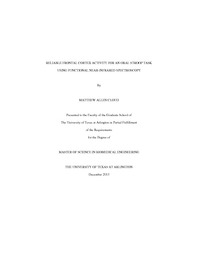
ATTENTION: The works hosted here are being migrated to a new repository that will consolidate resources, improve discoverability, and better show UTA's research impact on the global community. We will update authors as the migration progresses. Please see MavMatrix for more information.
Show simple item record
| dc.contributor.author | Cloud, Matthew Allen | en_US |
| dc.date.accessioned | 2014-03-12T23:50:37Z | |
| dc.date.available | 2014-03-12T23:50:37Z | |
| dc.date.issued | 2014-03-12 | |
| dc.date.submitted | January 2013 | en_US |
| dc.identifier.other | DISS-12492 | en_US |
| dc.identifier.uri | http://hdl.handle.net/10106/24113 | |
| dc.description.abstract | Analysis tools such as HomER and NIRS-SPM for functional Near-Infrared systems are commercially or freely available; however, they are difficult for clinicians to use as an assessment tool. One barrier to their use is the reliability of a given functional test. Intraclass correlation coefficients (ICC) provide a measure of group and individual reliability. NIRS-SPM was extended with ICC to assess a two part modified Stroop task. The protocol was repeated once every two weeks over a period of one month. Changes in neural activity attributed to inhibition of distraction, show significant covariance to the protocol with moderate to strong reliability for the group, and moderate reliability for individuals in the medial and left frontopolar and dorsolateral cortex. In addition, as the inhibitory response increases, neural activity shows a decrease in these same areas. This methodology could be extended to aid clinicians for group and individual patient comparisons. | en_US |
| dc.description.sponsorship | Liu, Hanli | en_US |
| dc.language.iso | en | en_US |
| dc.publisher | Biomedical Engineering | en_US |
| dc.title | Reliable Frontal Cortex Activity For An Oral Stroop Task Using Functional Near Infrared Spectroscopy | en_US |
| dc.type | M.S. | en_US |
| dc.contributor.committeeChair | Liu, Hanli | en_US |
| dc.degree.department | Biomedical Engineering | en_US |
| dc.degree.discipline | Biomedical Engineering | en_US |
| dc.degree.grantor | University of Texas at Arlington | en_US |
| dc.degree.level | masters | en_US |
| dc.degree.name | M.S. | en_US |
Files in this item
- Name:
- Cloud_uta_2502M_12492.pdf
- Size:
- 3.123Mb
- Format:
- PDF
This item appears in the following Collection(s)
Show simple item record


